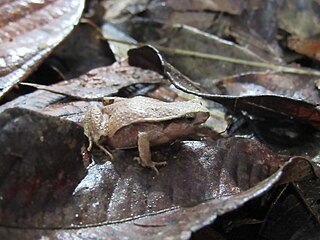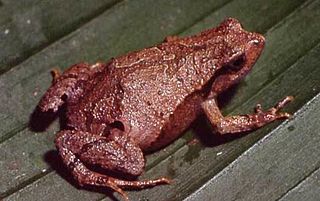Physalaemus albifrons is a species of frog in the family Leptodactylidae. It is endemic to Brazil. Its natural habitats are subtropical or tropical moist lowland forests, dry savanna, moist savanna, subtropical or tropical dry shrubland, subtropical or tropical moist shrubland, and intermittent freshwater marshes. It is threatened by habitat loss.

Physalaemus atlanticus is a species of frog in the family Leptodactylidae. It is endemic to Brazil. Its natural habitats are subtropical or tropical moist lowland forests, freshwater marshes, and intermittent freshwater marshes.

Physalaemus biligonigerus is a species of frog in the family Leptodactylidae. It is found in Argentina, Bolivia, Brazil, Paraguay, and Uruguay. Its natural habitats are subtropical or tropical dry forests, temperate shrubland, subtropical or tropical dry shrubland, subtropical or tropical moist shrubland, temperate grassland, subtropical or tropical dry lowland grassland, subtropical or tropical seasonally wet or flooded lowland grassland, freshwater lakes, intermittent freshwater lakes, freshwater marshes, sandy shores, arable land, pastureland, plantations, rural gardens, urban areas, heavily degraded former forest, water storage areas, ponds, irrigated land, seasonally flooded agricultural land, and canals and ditches.
Physalaemus bokermanni is a species of frog in the family Leptodactylidae. It is endemic to Brazil. Its natural habitats are subtropical or tropical moist lowland forests and intermittent freshwater marshes. It is threatened by habitat loss.

Physalaemus caete is a species of frog in the family Leptodactylidae. It is endemic to Brazil. Its natural habitats are subtropical or tropical moist lowland forests and intermittent freshwater marshes. It is threatened by habitat loss.

Physalaemus centralis is a species of frog in the family Leptodactylidae. It is found in Bolivia, Brazil, and Paraguay. Its natural habitats are moist savanna, subtropical or tropical moist shrubland, subtropical or tropical seasonally wet or flooded lowland grassland, freshwater marshes, and intermittent freshwater marshes. It is threatened by habitat loss.

Physalaemus cicada is a species of frog in the family Leptodactylidae. It is endemic to Brazil. Its natural habitats are dry savanna, moist savanna, and intermittent freshwater marshes. It is threatened by habitat loss.

Physalaemus crombiei is a species of frog in the family Leptodactylidae. It is endemic to Brazil. Its natural habitats are subtropical or tropical moist lowland forests and intermittent freshwater marshes. It is threatened by habitat loss.

Physalaemus cuqui is a species of frog in the family Leptodactylidae. It is found in Argentina, Bolivia, and possibly Paraguay. Its natural habitats are subtropical or tropical dry forests, subtropical or tropical dry shrubland, subtropical or tropical moist shrubland, intermittent freshwater marshes, arable land, pastureland, ponds, irrigated land, and canals and ditches.

Physalaemus cuvieri is a species of frog in the family Leptodactylidae. It is found in Argentina, Brazil, Paraguay, and possibly also Bolivia, Guyana, Uruguay, and Venezuela. Its natural habitats are subtropical or tropical moist lowland forests, moist savanna, subtropical or tropical dry lowland grassland, subtropical or tropical seasonally wet or flooded lowland grassland, intermittent freshwater lakes, intermittent freshwater marshes, arable land, pastureland, plantations, rural gardens, urban areas, heavily degraded former forest, ponds, irrigated land, seasonally flooded agricultural land, and canals and ditches. It is threatened by habitat loss.
Physalaemus erythros is a species of frog in the family Leptodactylidae. It is endemic to Brazil. Its natural habitats are subtropical or tropical moist shrubland, subtropical or tropical high-altitude grassland, intermittent freshwater marshes, and rocky areas. It is threatened by habitat loss.
Physalaemus evangelistai is a species of frog in the family Leptodactylidae. It is endemic to Brazil. Its natural habitats are subtropical or tropical moist shrubland, subtropical or tropical seasonally wet or flooded lowland grassland, swamps, and intermittent freshwater marshes. It is threatened by habitat loss.

Physalaemus fernandezae is a species of frog in the family Leptodactylidae. It is found in Argentina, Uruguay, and possibly Brazil. Its natural habitats are subtropical or tropical seasonally wet or flooded lowland grassland, intermittent freshwater marshes, and rocky areas. It is threatened by habitat loss.

Physalaemus henselii is a species of frog in the family Leptodactylidae. It is found in Argentina, Brazil, and Uruguay. Its natural habitats are subtropical or tropical seasonally wet or flooded lowland grassland, intermittent freshwater marshes, pastureland, rural gardens, and urban areas. It is threatened by habitat loss.

Physalaemus lisei is a species of frog in the family Leptodactylidae. It is endemic to Brazil. Its natural habitats are subtropical or tropical moist lowland forests, moist savanna, and intermittent freshwater marshes. It is threatened by habitat loss.
Physalaemus maximus is a species of frog in the family Leptodactylidae. It is endemic to Brazil. Its natural habitats are subtropical or tropical moist montane forests, swamps, and intermittent freshwater marshes. It is threatened by habitat loss.

Physalaemus nanus is a species of frog in the family Leptodactylidae. It is endemic to Brazil. Its natural habitats are subtropical or tropical moist lowland forests, intermittent freshwater marshes, rural gardens, heavily degraded former forest, irrigated land, seasonally flooded agricultural land, and canals and ditches. It is threatened by habitat loss.

Physalaemus riograndensis is a species of frog in the family Leptodactylidae. It is found in Argentina, Brazil, Paraguay, and Uruguay. Its natural habitats are subtropical or tropical seasonally wet or flooded lowland grassland, freshwater marshes, intermittent freshwater marshes, arable land, pastureland, ponds, seasonally flooded agricultural land, and canals and ditches.
Physalaemus santafecinus is a species of frog in the family Leptodactylidae. It is found in Argentina and possibly Paraguay. Its natural habitats are temperate grassland, intermittent freshwater lakes, intermittent freshwater marshes, and pastureland. It is threatened by habitat loss.

Physalaemus spiniger is a species of frog in the family Leptodactylidae. It is endemic to Brazil. Its natural habitats are subtropical or tropical moist lowland forests, subtropical or tropical moist shrubland, intermittent freshwater lakes, and intermittent freshwater marshes. It is threatened by habitat loss.















